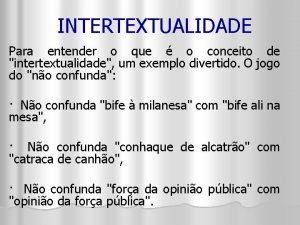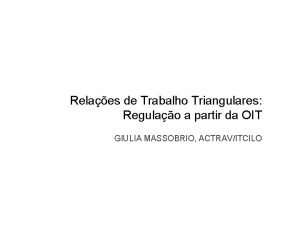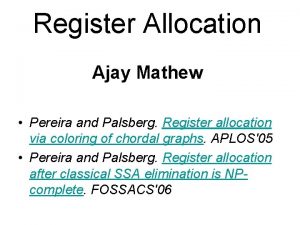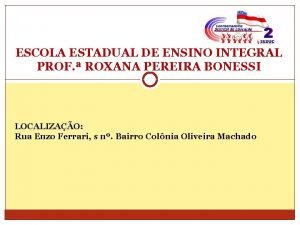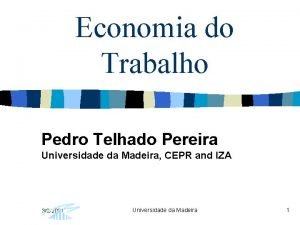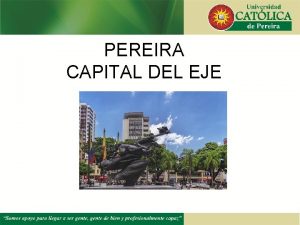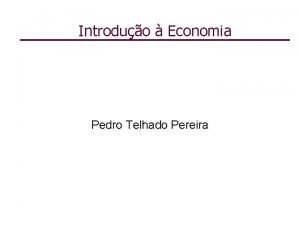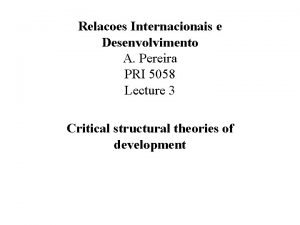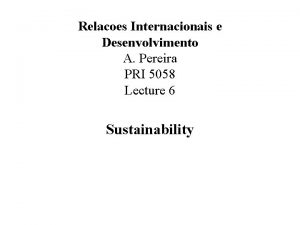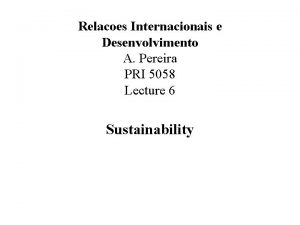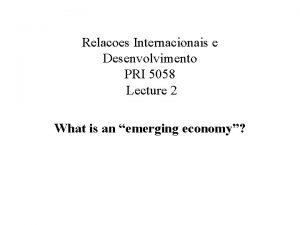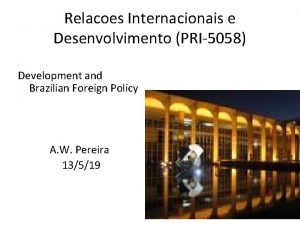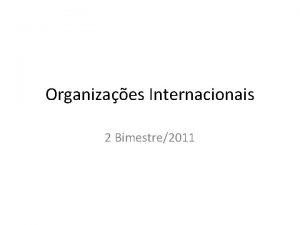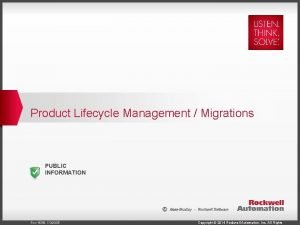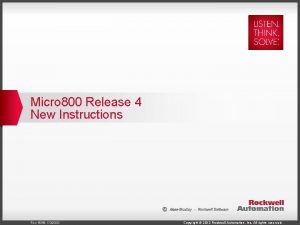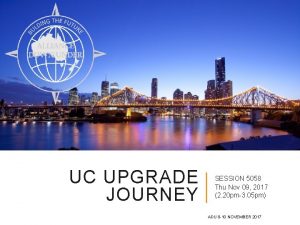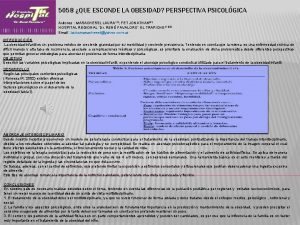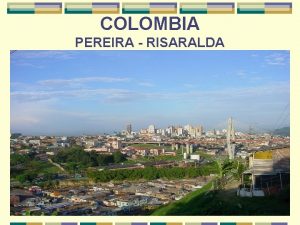Relacoes Internacionais e Desenvolvimento A Pereira PRI 5058








































- Slides: 40

Relacoes Internacionais e Desenvolvimento A. Pereira PRI 5058 Lecture 5 Neoliberalism

Questions • What is neoliberalism and what are its origins? • Through what mechanisms did neoliberalism become a globally dominant ideology and set of practices? • What is the record of neoliberal approaches to development? • Is the era of neoliberal dominance over?

Outline • • • Examples Origins Emergence Diffusion Ideas and practice – strengths and weaknesses • Decline? • Conclusion

Examples of neoliberal policies • ?


Some examples • Privatisation of SOEs and state infrastructure (airports, roads, railways, ports, etc. ) • Liberalisation of capital markets • The “flexibilisation” of labour markets • The privatisation of state pensions • School vouchers

Other features of neoliberal reform • Reductions in the fiscal deficit (cut spending, increase revenues, or both – in practice, often meant cuts in spending and investment, reductions in state salaries and personnel, and elimination of state functions) • De-regulation (or more accurately, re-regulation) • Reductions in tariffs, quotas, capital controls, and other impediments to trade and investment (economic “opening”) • Privatisation of state-owned enterprises • An increase in exports and facilitation of debt repayment • Decentralisation of some state functions • Reduction of tax burdens

Neoliberalism as theory • Representative theorists: Friedrich von Hayek; Milton Friedman; Sebastian Edwards. [Note: they would consider themselves neoclassical economists or libertarians. ] • Major influences: neo-classical economics and the Austrian School of economics. • The market as “natural” and in need of protection by a strong rule of law and a minimalist, but effective state (see Hayek on the rule of law) • State intervention distorts market incentives and usually makes social outcomes worse. The cost of nonmarket allocation of resources usually outweighs the benefits. State failure and “rent-seeking” by states is a bigger problem than market failure. • Most states should be “rolled back”, with many of their functions replaced by markets.

Alternative theoretical positions • New institutional economics (Coase, North, Williamson, Stiglitz) • Markets are imperfect more often than neoliberals allow, and are marked by information asymmetries and transaction costs. • Effective institutions (both state and non-state) are needed to lower transaction costs and facilitate market transactions – institutions such as judicial systems, property rights regimes, regulatory agencies, central banks, insurance, etc. • Neostructuralists/neo-Keynesians (neo-developmentalists; i. e. Ha-Joon Chang, Paul Krugman, L. C. Bresser-Pereira) • Developing economies differ fundamentally from advanced capitalist economies. • Significant state activity is needed to overcome market imperfectionsmore activity than advocated by new institutionalists. • Elements of the desarollista or import-substitution industrialization (ISI) model were more effective than neoliberals claim • (Also versions of what we have studied so far: Marxism, dependency theory, post-development, etc. )

Origins • F. von Hayek, The Road to Serfdom (1944). • 1945 -71: a period of embedded liberalism in the world economy (state mediated capitalism with strong labor rights, curbs on capital mobility, welfare rights, Keynesian demand management and some degree of state planning). • “Stagflation” challenged the Keynesian orthodoxy. • The oil shock of 1973 -4 put “petrodollars” into the world economy, and by borrowing these many developing countries sustained ISI during the 1970 s. • The Pinochet reforms in the 1970 s were an experiment in neoliberal reform.


Origins • Chinese economic reforms under Deng Xiaoping beginning in 1978 • The second oil shock of 1979 • US interest rates rise • Thatcher elected in the UK in 1979 • Reagan elected in the US in 1980 • The 1980 s: a debt crisis in much of the developing world, in which capital flows were from developing to the developed world


Emergence Neoliberal reform in Latin America in the 1980 s and 1990 s • Africa: IMF structural adjustment policies • India: liberalization beginning in the 1990 s • East Asia: the crash of 1997 • Neoliberalism as an arm of US foreign policy: `free markets + democracy’

Diffusion: the Washington Consensus The “Washington Consensus” described by Williamson (1989) included: • Fiscal discipline • Reduction of subsidies and investment in infrastructure, education and health • Tax reform (lower marginal rates and broader base) • Interest rates that are market determined • Exchange rates that are market determined • Liberalization of trade and investment • Legal security for property rights • Privatization of SOEs

The rise of Japan: a developmental state?

The role of the IFIs • World Development Report: Trade and Industrialization (1987) • The Japanese government reacts • The East Asian Miracle: Economic Growth and Public Policy (1993) • World Development Report: The State in a Changing World (1997)

Theory, prescription, practice • Understanding the difference between neoliberalism as theory, prescription, and practice helps unlock the current debate. • Neoliberals argue that the reforms’ disappointing results have more to do with incomplete and/or distorted implementation of the policies, and that the policies and theory behind them are still fundamentally sound. • Critics argue that the last three decades of reform show that both theory and the prescriptions have been tried and have been shown to be inadequate. • There are now many critics in the advanced capitalist countries, who attack neoliberalism for undermining national cohesion.

The Politics of Neoliberal Reform • World Bank’s first SAP (1979). • IMF and World Bank promote economic liberalisation (not contemplated in Bretton Woods accords) by attaching conditions to new lending (“conditionality”). The region most directly affected: Latin America, followed by Sub-Saharan Africa.

Neoliberals raised the question of the optimal mix of state strength and scope Low scope high strength High scope high strength Low scope low strength High scope low strength

Mexican SOEs, 1930 -1980 • • • 1930 1940 1950 1960 1970 1980 12 57 158 259 491 1, 155 – Source: Williams (2001): 62.

The Mexican public sector, 19701983 • • • Public sector employees 1970 616, 000 1976 2. 1 million 1983 3. 3 million Increase in public sector budget 1970 -76: 116% (GDP increased 51%) – Source: Centeno (1994): 82.

A justification for neoliberal reform • Pedro Aspe, Finance Minister in Mexico in address to Congress in 1989: “The crisis has shown us that a larger State is not necessarily a more capable State; a State that owns more is not necessarily a State that is more just. The truth is, in Mexico, more State has meant less capacity to respond to the social needs of our fellow countrymen and, in the end, greater weakness of the State itself. All the time the activity of the public sector was increasing, attention to the problems of highest social priority was decreasing. ” Source: Dominguez (1997): 132.

Problems with ISI • Little state leverage over stagnant firms • Dualistic labor market economies (privileged formal/state sector, deprived informal/private sector) • SOEs often used for patronage • High state debt – this often fuelled inflation • “Rent-seeking”and predation

Who implemented neoliberal reforms? • ?

Implementation • Insulated, technocratic elites in the executive, working with IFIs (“technopols”) • Lots of Ph. Ds in Economics • Tight international networks (the example of Foxley, Aspe, Cavallo – all studied together at MIT under Rudiger Dornbusch) • Pedro Malan, Finance Minister of Brazil (1995 -2003) had been at the World Bank

Tensions in the politics of reform • Neoliberal reformers sometimes used tactics for building political support that undermined the logic of their economic policies. For example, President Carlos Menem (1989 -1999) in Argentina allowed governors to run fiscal deficits in the provinces in order to retain their loyalty, and President Cardoso in Brazil (1995 -2002) used public resources to buy political support for a second term in Congress. • Sometimes candidates campaigned against neoliberal reform and then implemented it once elected (i. e. Menem in 1989, Fujimori in 1990).

Some positive results of neoliberal reforms • • • Some resumption of growth Relative price stability Fiscal imbalances often corrected Mitigation of debt crisis Increase in exports Improved services in some sectors (i. e. telecommunications)

Some negative results of neoliberal reforms • Low growth • Little improvement in firm management and productivity • Widening inequality – emergence of new super-rich elite • Little poverty reduction • Financial and economic volatility • Environmental and social deterioration • Decline in state capacity – state disintegration

The



World Inequality Report 2018, by F. Alvaredo, L. Chancel, T. Piketty, E. Saez and G Zucman and released by the World Inequality Database



From the World Inequality Report 2018


Conclusion • It is important to distinguish between neoliberal theory, prescription and practice. • Part of the appeal of neoliberalism is that it seems to fit the “common sense” perceptions of many in business and it also appeared to be a solution to the crisis of the ISI model and the debt crisis. • In some sectors the replacement of state allocation of goods and services by markets appeared to work well (i. e. telecommunications). In others it did not. • In some countries privatizations were dominated by a small coterie of oligarchs (Argentina, Russia) whereas in others private ownership was more broadly shared.

Conclusion • The high water mark of the neoliberal wave was probably the mid-1980 s to the end of the 1990 s, when the “Washington Consensus” was dominant. • The 2008 -9 financial crisis dented confidence in neoliberal practice. • The Washington Consensus was replaced by a “post. Washington Consensus” – a “new institutionalist” emphasis on “second generation” institutional reforms and compensatory social programmes such as conditional cash transfers (CCTs). • US foreign policy has changed: The “Trump Doctrine” is supposedly about a “return to national sovereignty; national interest; reciprocity in international relations and trade; burden sharing, especially in defense; and new regional partnerships for particular crises” (Kiron Skinner).

Conclusion • Is the neoliberal era over? • Yes, if neoliberalism means the market fundamentalism of the Washington Consensus. (The latter probably never enjoyed the support of the majority in developing countries in the first place. ) • No, if neoliberalism means market-oriented development characterised by export-led growth, openness to foreign capital, and low rates of trade protection. While the latter orientation has waned in the current nationalist and protectionist climate, it is still the default position for many governments, multilateral institutions and aid agencies.
 Realismo nas relações internacionais
Realismo nas relações internacionais Ufmg relações internacionais
Ufmg relações internacionais Unidades internacionais
Unidades internacionais Amor nao correspondido
Amor nao correspondido Relações intergeracionais significado
Relações intergeracionais significado Projeto de vida ensino fundamental
Projeto de vida ensino fundamental Relações semânticas
Relações semânticas Triangulo retangulo
Triangulo retangulo Relações harmonicas protocooperação
Relações harmonicas protocooperação Parasitismo
Parasitismo Chiavenato estilos de liderança
Chiavenato estilos de liderança Amensalismo
Amensalismo A escola das relações humanas
A escola das relações humanas 3 fase da experiência de hawthorne
3 fase da experiência de hawthorne Sinfilia
Sinfilia A escola das relações humanas
A escola das relações humanas Inquilinismo
Inquilinismo Personalidade evitante
Personalidade evitante Relações triangulares
Relações triangulares A escola das relações humanas
A escola das relações humanas Tg 45º
Tg 45º Relações trigonométricas fórmulas
Relações trigonométricas fórmulas Relação fonética e gráfica entre as palavras
Relação fonética e gráfica entre as palavras Homófonos
Homófonos Instrumentos de relações públicas
Instrumentos de relações públicas Teorias de mayo
Teorias de mayo Dra gracian li pereira epidemiologista
Dra gracian li pereira epidemiologista Mathew pereira
Mathew pereira Dez mandamentos versículo
Dez mandamentos versículo Fernando leal pereira dos santos
Fernando leal pereira dos santos Escola roxana pereira bonessi
Escola roxana pereira bonessi O que é argumentos?
O que é argumentos? Pedro telhado
Pedro telhado Geraldo pereira jotz
Geraldo pereira jotz Maria lusa
Maria lusa Ignatius pereira journalist
Ignatius pereira journalist Mapa del clima en pereira
Mapa del clima en pereira Bienestarina animada
Bienestarina animada Estrutura interna e externa da farsa de ines pereira
Estrutura interna e externa da farsa de ines pereira Pedro telhado pereira
Pedro telhado pereira Sardas pereira
Sardas pereira



